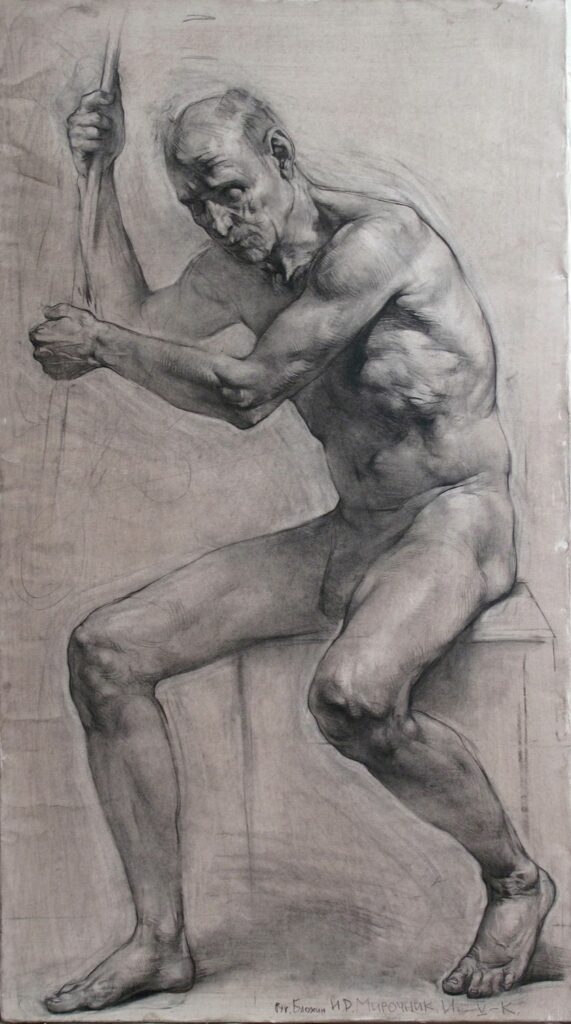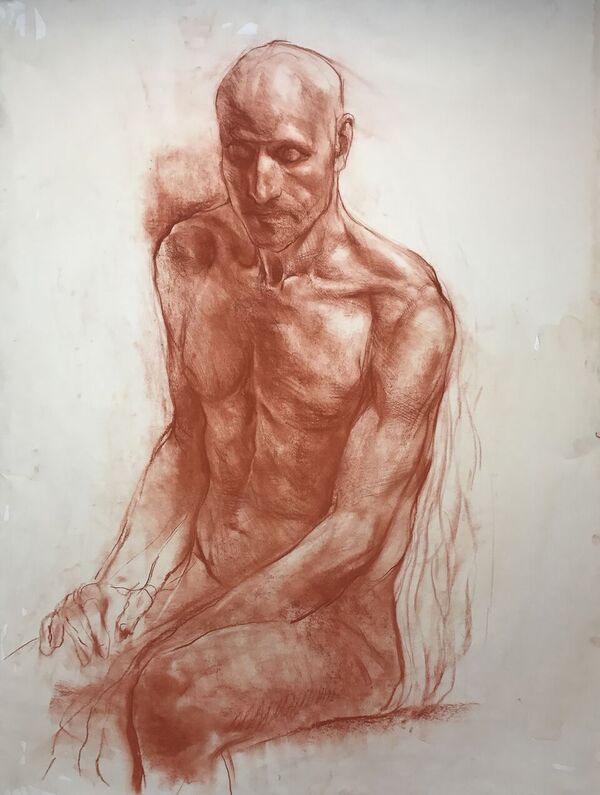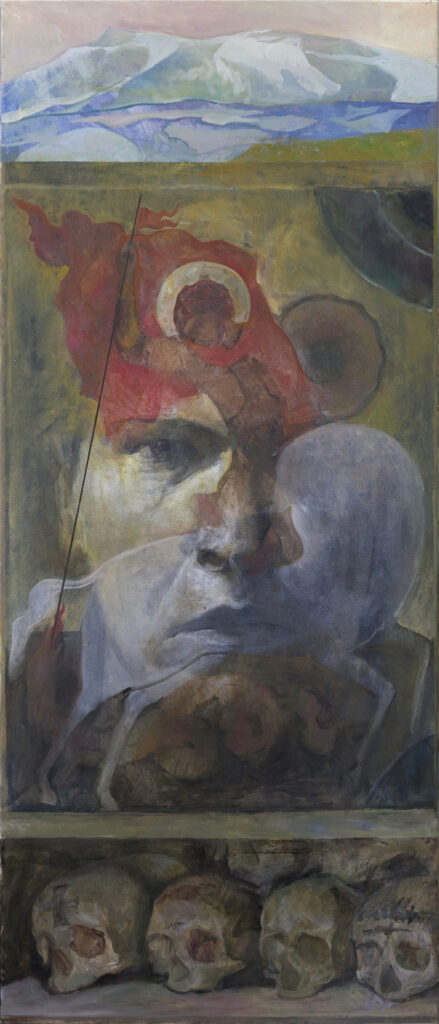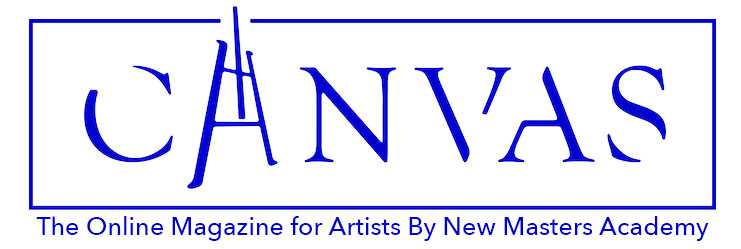New Masters Academy is updating the Russian academic drawing course over the next several weeks starting with new in-depth content of multi-figural drawing followed by a full course in drapery drawing and plaster cast drawing, taught by NMA instructor Iliya Mirochnik.
What makes Iliya Mirochnik so valuable, both as an artist and
I met Mirochnik during an informal dinner while he was here in Southern California to create a number of instructional videos for New Masters Academy. I was struck by his affable manner and lighthearted nature, and that we shared an appreciation for Kings Blue, Rembrandt.
I saw him again the next week amidst large lights and cameras, as he
was busy at work demonstrating how to render draping cloth according to his Russian Academic Drawing techniques. A few hours later he bounded from the shoot, beaming, “This was the best so far!”
Mirochnik offered his insight into his training, art, and life in the following interview:

Canvas: When and how did you connect with the Russian Academic Drawing approach?
I was born in Odesa, Ukraine, which at that time was still part of the USSR. My parents and I immigrated to Israel and then again to the United States when I was 5 or 6.
We settled in Brooklyn, New York. I was brought up in a Russian speaking household, but, being in Brooklyn, a melting pot of sorts, I had a lot of friends from diverse backgrounds. It was an excellent opportunity to be exposed to that kind of community.
This year actually marks 20 years since I started drawing, at about the age of 11, which if you think about it, is not actually that early. It’s a young age to start training, perhaps, but I wasn’t one of those kids that drew for as long as they could hold a pencil. My parents were always supportive and did a lot to expose me to all kinds of “traditional culture” such as dance, classical music, museums, and the like. My parents, being of a certain Eastern European/ Soviet mentality when it comes to education, quickly enrolled me in proper art classes once I began to show interest. I had studied a little bit of classical guitar before then and played some sports. The idea was that if I showed an interest in anything, it had to be “cultivated” immediately. There isn’t as much initial “free play” as there is in American education, for better or for worse.
So I was immediately plunged into studying traditional techniques with Russian-trained artists in New York, which was really great because I was getting a certain kind of formal artistic training that to my knowledge was not readily available anywhere else, especially with no internet to help guide the way. When it came time to go to college I enrolled in my dream school, the Repin Academy of Fine Arts in St. Petersburg, Russia, a Hogwarts of an art academy with a 260-year-old tradition, it was absolutely incredible.
Canvas: What did you have to overcome to be a successful artist?
For me, my first obstacle (and one that doesn’t seem to go away) is myself.
I believe that to be successful, an artist needs to balance two forms of development. An artist can, at any time, play to his or her strengths, or to his or her weaknesses. The former is a more commercial path, in which you develop a particular set of skills that, in essence, must immediately set you apart from everyone else. The latter route is one that focuses more on the “journey than the destination,” concentrating on constant growth and development, picking those creative challenges that pose the most difficulty. The balance of these two is the biggest obstacle, and one takes precedence over the other at various points in one’s education and career.
In general, the technique is not that much of an obstacle anymore, because that was the primary hurdle in art school – “getting things right.” Now I often have to work against my technique, see how an idea requires a loss, in a sense, of what one might call traditional drawing or painting ability. A similar obstacle is working with and against your personal biases and ideas, developing them in whatever way one can, and being open to changing your mind.
As for the career I, by no means, think that struggle is over either. The finding and assertion of one’s own voice seem like a life-long process. Playing to my strengths is now much more critical in developing my own artistic “image” both for myself and for others.
So in short, I’m trying to balance the two.
Canvas: How would you describe your work, genre, or style? What sets it apart from others?
This is quite a difficult question! In general, my work is about the disconcerting aspects of everyday life. Specifically, it deals with my personal life, especially the interactions with those close to me, and the world around me. It’s a restrained (for now) imaginary realism.
I strive to tell personal stories and to allow the style and medium to work towards that goal, not the other way around.
I think the artist is often paradoxically too subjective in their interpretation of the world, preventing them from reaching the more profound subjectivity that comes with allowing the world around them to influence their views. Even when I paint about something outside of my immediate life, like paintings influenced by poetry and poets, it all ends up being autobiographical.

Canvas: What are your ideal materials to work with?
This is something that keeps developing in my practice. The medium is one of the most essential elements of artistic practice. We can’t escape that overused quote by Marshall McLuhan that “the medium is the message.” I allow the idea to affect the medium of choice. For example, a recent piece I did entitled “Lot’s Wife”, initially inspired by two eponymous poems, one by Anna Akhmatova and the other by Nonna Slepakova, is a portrait of my mother, and was created with torn texts, books, and magazine working to highlight the way the paper imitates stone when used in this collage-like manner, but also underscoring the importance of writing, language and other aspects of the immigration experience and poetry itself. But it’s the transience and perishability of the paper itself that’s meant to deliver the real punch.
Canvas: What is a typical day for you?
An ideal day for me is one where some kind of learning happens. It can go in multiple ways. One type of perfect day involves waking up early, exercising, reading, teaching, art-related practice, cooking, talking, relaxing, and going to bed early, not necessarily in that order, but preferably.
Another kind of ideal day would be walking around in some old European town with my partner, and maybe doing a sketch or a painting of a view for no more than 2 hours.
Canvas: What do you recommend to students and young aspiring artists?
Even though I teach as a profession, I’m hesitant to offer too much advice that isn’t practical (from an artistic standpoint). My main job is to make my students interested in art, to learn to love art, to make art a part of their everyday lives. If they do this, then the sometimes tricky, practical side, will not seem all that difficult. They need to keep learning but also engage in other activities, artistic or not, because it’ll all play into who they are as artists and technicians.
Canvas: How do you describe the art world today and your place in it?
The art world today is challenging to describe because it isn’t one space. There are many different art worlds, and due to the Internet, we can witness all of them at any point in time. Even within what maybe one can call the realm of “representational art,” there are many different divisions, based on various factors. Arguments such as “naturalism vs. stylization”, “realism vs. abstraction”, “perception vs. concept” are never-ending and not helping to bring people together.
You divide the art world geographically. Britain has a fascinating tradition of representational art that “survived” the post-modern/contemporary influence that affected America and the rest of Europe. China has an art scene all of its own that’s a strange mix of the desire to fit into a mold combining Western artistic ideas, a traditional Chinese aesthetic, and the effect of academic education brought in from the Soviet Union.
Then, of course, there’s the elephant – the “contemporary art scene” – which has some exciting innovations and ideas but is, for the most part, something outside of visual art as we “traditionalists” perceive it. In a sense, it’s some sort of post-art.
And finally, there is contemporary painting, which can, but doesn’t have to, be representational, but is mostly conceptual in its primary goals, and can range a great deal in quality, depth, and vision.
As difficult a thing to describe, the art world is nevertheless, quite exciting, albeit confusing, often shallow, and tumultuous.
I heard someone say that today’s artists, writers, poets, etc., need the first 30 years of our lives to get through all of the art done before us, before really being able to make anything of one’s own. I think there’s something to that.
Where I fit in is probably an even harder question to answer because I don’t feel like I fit in any one artistic subculture. I think if one wants to be particularly analytical, one can devise a system of “sliders,” as you find in photo-editing software, each one seemingly representing a binary of sorts, like the above-mentioned “naturalism vs. stylization,” and plot where one is as an artist. This might be a new way to classify oneself in an increasingly complex art world. I find this a little too reductive. I prefer to do what feels right, imitate these types of distinctions less, and see how other people choose to “sort” me.

Canvas: Inspiration – where do you go for it? What inspires you?
I have a somewhat romantic and mystical perception of inspiration. I think of it as something outside of myself that just comes and goes as it pleases. You just have to keep working while you wait for it. A great deal of my work aside from just painting and drawing, in the wait or search for inspiration, is mining other artist’s work, my personal life, interactions with people, poetry, books, new techniques and media, music, etc. Basically, I find that learning all kinds of things is what keeps things moving. In a sense, I’m trying to find inspiration where I can, but inspiration will contact me when it wants to, and not the other way around. In the meantime, you have to keep being interested in things and painting “through” those less inspired moments. The best part is looking back at those “uninspired” paintings a little later and realizing that there was more there than you thought in the first place.
Canvas: What are some additional interests that you have?
I have quite a few interests outside of the visual arts. I love poetry, language, translation, but also cooking and have spent quite some time learning these things. In the end, it all leads back to the visual arts. In learning about the structure of poetry I saw parallels to pictorial composition, and in exploring cooking and baking, I saw many ways in which I can package concepts to better transfer them to my students.




Leave A Reply